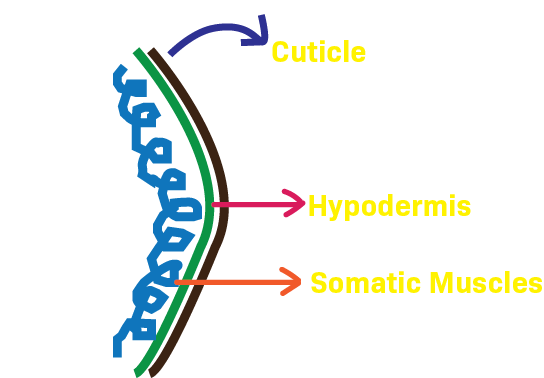🧖🏽♀️ Morphology
Learn about outer body structure of plant parasitic nematodes and different structures associated with cuticle
Which of the following is correct regarding nematode?
👉🏻 The outer body tube or body wall comprises of three layers:
- Outermost Layer: Cuticle
- Middle Layer: Hypodermis
- Innermost Layer: Somatic Longitudinal Muscles

Cuticle
- The cuticle is a
non-living,non-cellular, triple–layers covering that is secreted by the underlying hypodermis. - The cuticle is flexible. It covers the entire body and lines the oesophagus, vulva, anus, cloaca, excretory pore and sensory organs.
- The feeding stylet and copulatory spicules are formed from cuticle. The external lining is known as exo-cuticle and internal linning is known as endo-cuticle.
- The composition and from of the cuticle is highly variable. In general, the cuticle is composed of three primary zones viz.,
- Cortical Layer
- Median Layer
- Basal Layer
- The cuticle of may nematodes have markings on the surface. They are varied and complex and have been often used by taxonomists to assist in the identification of various species.
- The cuticular markings are categorized into different types:
- Punctuation
- Transverse marking or Striations
- Longitudinal markings
Function
- Cuticle along with hypodermis forms the
exoskeletonof nematodes which provides a proper shape to the nematode body in conjunction with pseudocoelom. - This body wall protects the nematode from the harsh external environment, serves as the exoskeleton and provides the mechanism for movement of the organism through the soil and plant tissue.
- The body wall also contains much of the nervous and secretory – excretory systems, and it plays a role in the exchange of gases.
- It regulated permeability as the cuticle acts as a semipermeable membrane allowing entry of water and non-electrolytes but preventing entry of any undesirable elements.
- It responds to stimuli from the external environments through sensory structures associated with the surface of the cuticle.
- It also helps growth of the nematode body because of moulting. Nematodes on their development from J1 to adult, undergo
four moultsand in each moult, both exo and endocuticles are replaced by the new cuticle secreted from the hypodermis in a process calledEcdysis.
Caudal Alae
- A pair of lateral wing like cuticular expansion around the tail of the
male nematodeis called caudal alae. - It is commonly called
Bursa. - It helps male nematode to grasp and clasp the female during mating.
Amphid
- A pair of lateral chemo-sensory structure present on the surface of cuticle at the lateral lips located exactly opposite to each other.
- Amphids are the chemoreceptor structure which can detect any chemical changes on the outermost environment helping plant parasitic nematode to recognise the favourable host plant for feeding.

Phasmids
- Phasmids are pair of lateral chemo-sensory structure appearing as pore-like openings located in the mid tail region exactly opposite to each other.
- These are chemoreceptors structure which act on
scent trailattracting members of the same species to assemble together at the site of feeding.
Deirids
- A pair of lateral outgrowths on the centre of lateral field at the level just below the nerve ring on the surface of cuticle are deirids.
- Located exactly opposite to each other.
- They are
mechanoreceptorstructure determining the size of the pore space prior to entry of the nematode through the pore space.
Hypodermis
- Hypodermis is single live cellular layer.
- It is metabolically very active layer helping secretion and maintenance of the cuticle.
- It induces moulting helping formation of new cuticle from hypodermis by secretion of leucine amino peptidase enzymes.
- It acts as osmotic and ionic regulator.
- Act of energy reservoir part helping the nematode during starvation.
Somatic Longitudinal Muscles
- The innermost lining of body wall is somatic longitudinal muscles which are arranged in rows at the base of the hypodermis.
- Muscle cells are rich in glycogen that helps the nematode to utilize the stored glycogen during starvation.
- It helps in movement of nematodes.
References
- Walia, R. K and Bajaj, H. K (2014). Textbook of Introductory Plant Nematology. Directorate of Knowledge Management in Agriculture, ICAR, New Delhi.
- Ravichandra, N. G. (2019). Plant Nematology. I. K. International Publishing House Pvt. Ltd., New Delhi.
- Dasgupta, M. K. (1998). Phytonematology. Pilgrims Publishing
- Fotedar, D.N. & Handoo, Z.A. (1978) A revised scheme of classification to order Tylenchida Thorne, 1949 (Nematoda). Journal of Science, University of Kashmir (1975), 3, 55–82.
- Qing, X., Bert, W. Family Tylenchidae (Nematoda): an overview and perspectives. Org Divers Evol 19, 391–408 (2019).
- https://doi.org/10.1007/s13127-019-00404-4
- https://nematode.unl.edu/dolichod.htm
- http://www.nematologia.com.br/files/tematicos/6.pdf
Which of the following is correct regarding nematode?
👉🏻 The outer body tube or body wall comprises of three layers:
- Outermost Layer: Cuticle
- Middle Layer: Hypodermis
- Innermost Layer: Somatic Longitudinal Muscles

Cuticle
- The cuticle is a
non-living,non-cellular, triple–layers covering that is secreted by the underlying hypodermis. - The cuticle is flexible. It covers the entire body and lines the oesophagus, vulva, anus, cloaca, excretory pore and sensory organs.
- The feeding stylet and copulatory spicules are formed from cuticle. The external lining is known as exo-cuticle and internal linning is known as endo-cuticle.
- The composition and from of the cuticle is highly variable. In general, the cuticle is composed of three primary zones viz.,
- Cortical Layer
- Median Layer
- Basal …
Become Successful With AgriDots
Learn the essential skills for getting a seat in the Exam with
🦄 You are a pro member!
Only use this page if purchasing a gift or enterprise account
Plan
Rs
- Unlimited access to PRO courses
- Quizzes with hand-picked meme prizes
- Invite to private Discord chat
- Free Sticker emailed
Lifetime
Rs
1,499
once
- All PRO-tier benefits
- Single payment, lifetime access
- 4,200 bonus xp points
- Next Level
T-shirt shipped worldwide

Yo! You just found a 20% discount using 👉 EASTEREGG

High-quality fitted cotton shirt produced by Next Level Apparel